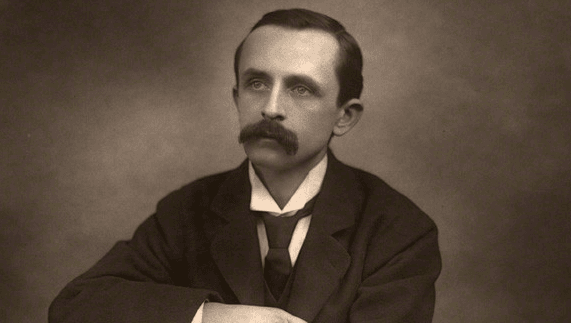
J.M. Barrie in 1892 by Herbert Rose Barraud.
J.M. Barrie was born in the tenements of Kirriemuir in Scotland on this day in 1860. We take a look at the tragic back story of his famous "Peter Pan" and his birthplace now a museum honoring the great writer.
Renowned playwright James Matthew Barrie
Matthew Barrie’s "Peter Pan", or "The Boy Who Wouldn’t Grow Up" premiered at the Duke of York’s Theatre in London on 27th December 1904 to critical and popular acclaim. Audiences were delighted by the whimsical story that took them away to Never Land. They did not know, however, that the seemingly childish fantasy about a boy who refused to grow up had taken root decades earlier in a mother’s grief over the death of Barrie’s older, 13-year-old brother.
According to Barrie biographer Andrew Birkin, while the boys’ mother “drew a measure of comfort from the notion that [her son], in dying a boy, would remain a boy forever, Barrie drew inspiration. It would be another 33 years before that inspiration emerged in the shape of "Peter Pan", but here was the germ, rooted in his mind and soul from the age of six.” Barrie’s mother never recovered from the tragedy, and young James strived to replace his brother, even wearing his sibling’s clothing.
Barrie was the ninth of ten children born to David Barrie and Margaret Ogilvy. (Following Scottish custom, she retained her maiden name.) He was born on 9th May 1860 at home in “The Tenements” at 9 Brechin Road in the small Scottish town of Kirriemuir, where the main industry was linen weaving. David Barrie was a better than- average weaver and housed his loom and yarn store on the bottom floor of the family’s two-storey house. A few years after James’ birth, his father rented a nearby shop for his business, and Margaret turned that room into a parlour. The two upstairs rooms included the kitchen and a bedroom.
Young James and his mother “read many books together when I was a boy, "Robinson Crusoe" being the first (and second)….” Margaret encouraged his growing literary interest and imagination, and James often questioned Margaret about her childhood and the people she had known. According to Barrie, “Those innumerable talks with her made her youth as vivid to me as my own, and so much more quaint….” Years later, Barrie committed these stories to paper and submitted them to newspaper editors, many of whom eagerly printed them. These were his first publishing successes.
Barrie lived at The Tenements until 1868 when he left home for Glasgow Academy. Steam-powered looms began overtaking the weaving industry, so David Barrie found work in the town of Forfar and moved his family there two years later. The Barries returned to Kirriemuir in 1872, but not to No. 9 Brechin Road.
Museum notes
J.M. Barrie’s Birthplace, Kirriemuir, Angus
Telephone: 01575 572646
Admission: adults £5, children and seniors £3.75, families £ 13.50
Hours: 12-5 Fri-Tue, April-June and Sept; 12-5 daily, July-August
More information can be found on the National Trust for Scotland website: www.nts.org.uk.
The house stood without distinction until a report began circulating in the 1930s that a certain party wished to buy the house and move it to the United States to open it as a Barrie museum. The alarm went up, and in 1937, soon after the author’s death, benefactor Duncan Ellidt Alves bought the property and donated it to the National Trust for Scotland, which maintains the site as a museum.
Visitors to the house see the parlour version of the first floor. Barrie memorabilia fills the room, including pieces of Margaret’s best china, an oak settle from the London flat on Adelphi Terrace that Barrie occupied at his death, and the 1937 contract between Barrie and six-year-old Princess Margaret, whom Barrie agreed to pay a penny per showing of his last play, The Boy David. They drew up the agreement after Barrie used a phrase of hers in the production. (Jack Llewelyn Davis had the first such contract with Barrie three decades earlier.)
Upstairs is a conjectural reconstruction of the family’s kitchen, furnished with paraphernalia typical of the mid-19th century. During reconstruction workers uncovered the original fireplace and installed a box bed to match the marks visible on the ceiling. With such a large family in only two rooms, a bed in the kitchen makes sense.
JAMES BARRIE WAS BORN in the house’s only other room, the bedroom. Here sit a typical Scottish cradle, Margaret’s nursing chair, and a box bed, with a Barrie family christening robe laid out. Family photographs adorn the walls, and the room also features two of the balloon-backed, hair-bottomed chairs Margaret bought. They arrived the day James was born, and a wry Barrie later claimed their delivery superseded his own in importance.
Next door and upstairs at No. 11 Brechin Road, visitors can tour the Exhibition Room. The display, “The Genius of J.M. Barrie,” features two tableaux. The first depicts Margaret beguiling a young James with stories of her childhood, and the second recreates a scene from Peter Pan, in which Peter flies through the Darling’s open window to visit Wendy. Next to Barrie’s massive wooden desk from his Adelphi flat stands a Peter Pan display case that includes two Peter Pan costumes worn by actresses Pauline Chase and Jean Forbes Robertson.
* Originally published in 2016, updated in May 2023.





Comments